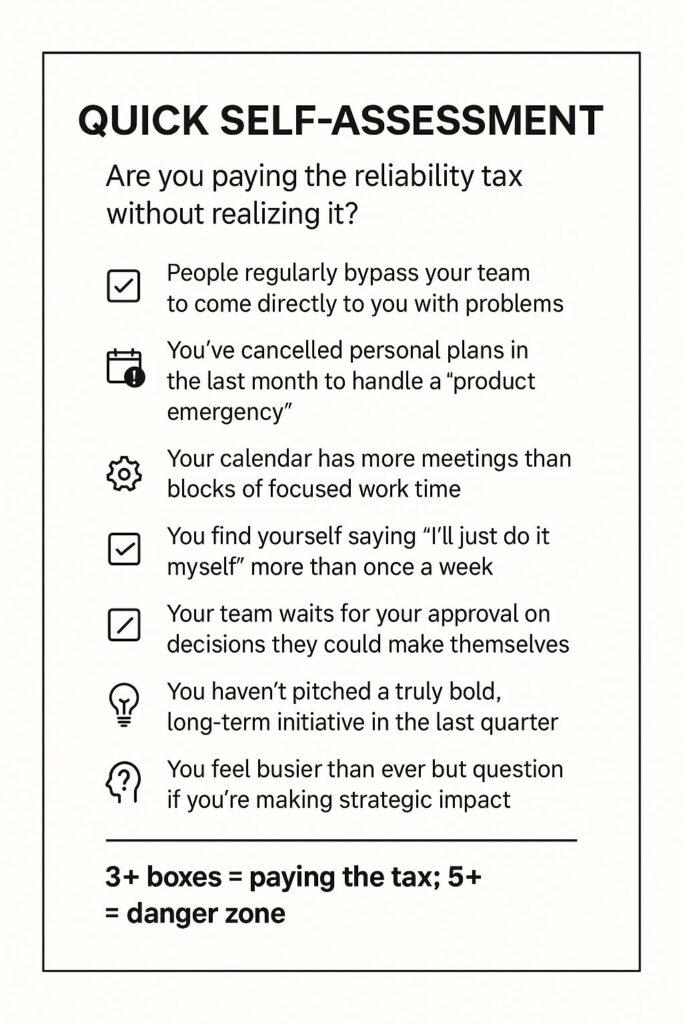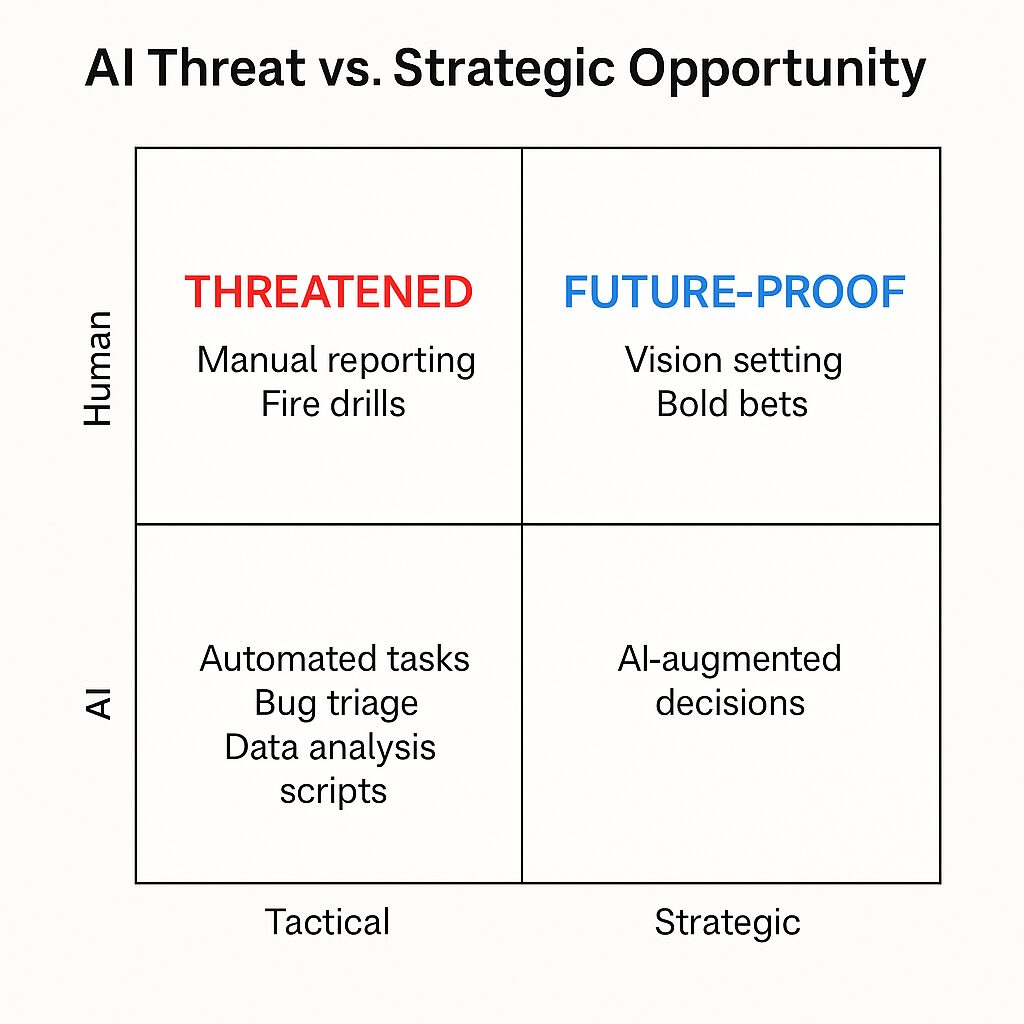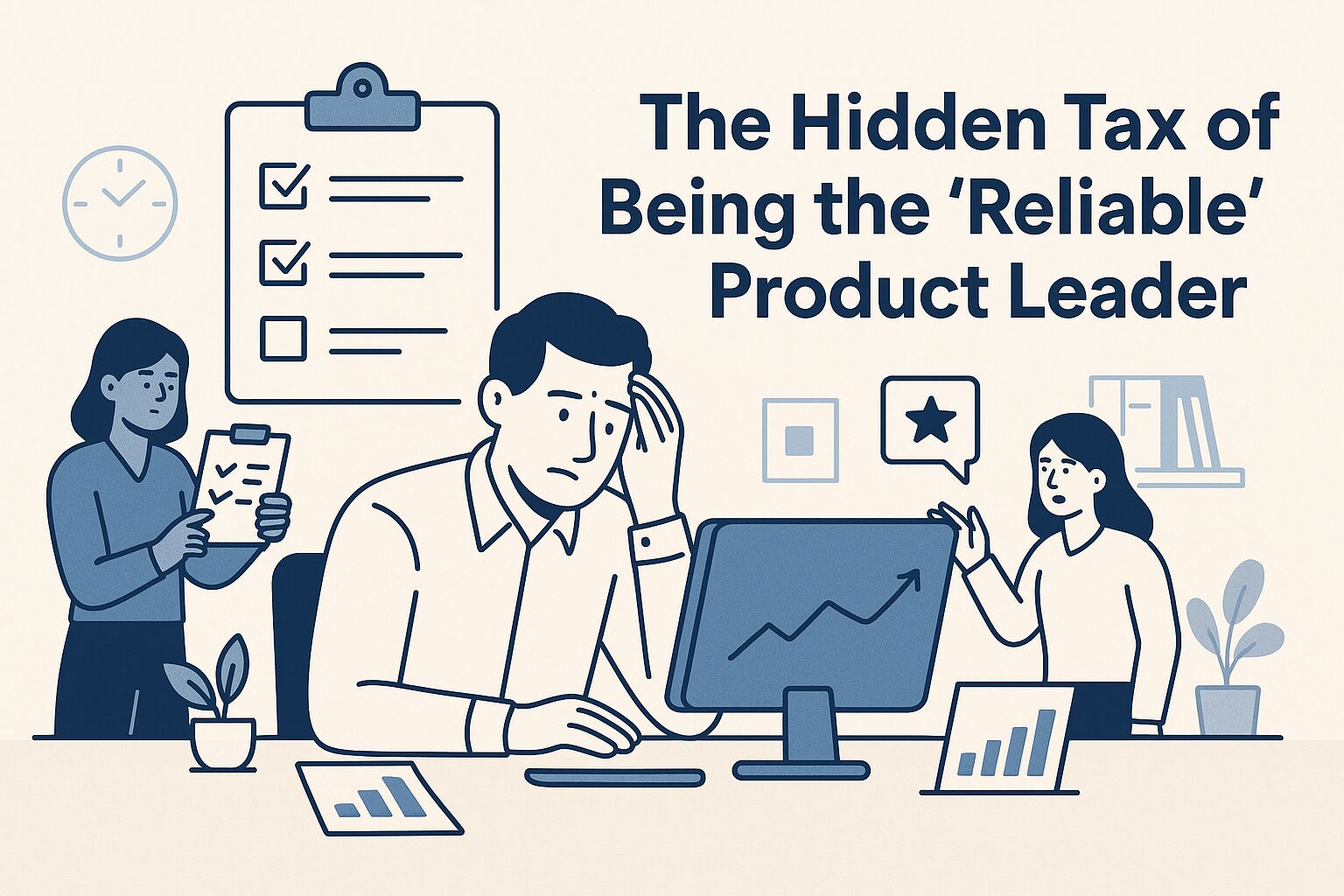Picture this: It’s 7 PM on a Tuesday, and you’re still at your desk. Again. The design team needed last-minute feedback, engineering hit a blocker that “only you could solve,” and sales dragged you into a client call because you’re the one who “really gets the product.”
Sound familiar? Welcome to the club of reliable product leaders – where being dependable has become your brand, and frankly, your prison. The consequences of this reliability are not just late nights at the office, but a career that’s stuck in the present, missing out on the strategic future.
Who This Is For: If you’re a senior product manager eyeing that VP or CPO role, or you’re already in product leadership but feeling stuck in tactical quicksand, this piece is your roadmap to a brighter, more strategic future. We’re discussing the transition from managing products to leading product strategy at scale, along with the exciting career growth that accompanies it.
When you’re the dependable one (the “safe pair of hands,” the person who always steps in), you build incredible trust. Your team loves you. Your boss relies on you. Your company sees you as indispensable. But here’s the brutal truth that took me years to learn: every “sure, I’ll handle it” comes with a hidden price tag that most reliable product leaders never see until it’s too late.
Quick Self-Assessment: Are You Stuck in the Reliability Trap?
Before we dive deeper, take 60 seconds to assess your current standing honestly. This isn’t just a checklist; it’s a mirror to your current situation.
Check all that apply:
People regularly bypass your team to come directly to you with problems.
You’ve cancelled personal plans in the last month to handle a “product emergency.”
Your calendar has more meetings than blocks of focused work time.
You find yourself saying “I’ll just do it myself” more than once a week.
Your team waits for your approval on decisions they could make themselves.
You haven’t pitched a truly bold, long-term initiative in the last quarter.
You feel busier than ever, but question if you’re making a strategic impact.
If you checked three or more boxes, you’re paying the ‘reliability tax’. If you checked 5+, you’re in the danger zone where being reliable is actively limiting your career growth. This isn’t just a tax on your time, it’s a tax on your potential.

What Most Product Leaders Get Wrong About Reliability
I thought I was crushing it. My performance reviews were glowing. My team was happy. But something was gnawing at me – despite all the praise, I felt like I was running in place.
The wake-up call came during a quarterly business review. While other product leaders were presenting bold new initiatives and strategic pivots, I was… reporting on things that had already happened. I’d become so busy being reliable that I’d stopped being strategic. I was in the weeds managing the present while my peers were designing the future.
That’s when I realized my fundamental mistake: I had focused on making myself needed instead of making myself valuable. The power to shape your career is in your hands.
Case Study: The Tale of Two Product Leaders
Let me illustrate this with two real examples that shaped my thinking:
The Reliability Trap in Action: A few years back, I watched a brilliant VP of Product at a Fortune 500 company get stuck in this exact pattern. Let’s call her Amy (not her real name). She was incredibly skilled, deeply technical, and had built enormous trust with her team. However, as the company scaled from 30 to 100 people, Amy continued to operate as if she were still the hands-on PM.
She was present at every design review, every technical spike, and every customer escalation. Her team loved her availability, but the business started to stagnate. While competitors were shipping AI-powered features and expanding into new markets, Amy’s team was optimizing existing flows. She was so busy being reliable that she missed the strategic inflection point. Eventually, the board brought in a new CPO who was more focused on vision than execution.
The Strategic Reliability Success: As Brian Chesky has shared in interviews and talks (including Masters of Scale and Fortune), he deliberately shifted from hands-on firefighting to architecting Airbnb’s long-term strategy, empowering leaders to handle operational challenges while he focused on transformative bets, such as Airbnb Plus and Experiences.
The difference? Amy scaled her availability. Brian scaled his impact.
Most reliable product leaders fall into this trap. Saying yes to every request, solving every problem, and being available 24/7 makes us indispensable. But what happens is we become expensive problem-solvers instead of strategic leaders.
The Three “Reliability Taxes” That Are Quietly Killing Your Career
Let’s be honest about what this costs you. These aren’t just productivity issues (they’re career-limiting taxes that compound over time).
1. The Focus Tax: When Deep Work Becomes Extinct
Every favor, every last-minute deck polish, every cross-team fire drill steals hours from the deep work that defines your product vision. Without focus, you become a PM on autopilot (tactical, reactive, and slowly disconnected from the why behind what you’re building).
I tracked my time for two weeks and discovered something horrifying: I was spending less than 20% of my time on actual strategic work. The rest was consumed by what I called “reliability theater” (activities that felt important but weren’t moving the needle).
Research from Georgetown’s Cal Newport shows that knowledge workers check email and Slack every 6 minutes on average. But for reliable product leaders, that number is even worse because we’ve trained everyone to expect immediate responses.
2. The Opportunity Tax: Missing the Forest for the Trees
When you spend your time patching gaps, you miss chances to champion transformative opportunities. You stop pitching bold ideas to the CEO. You stop looking around corners. You stop taking the smart risks that separate good product leaders from great ones.
The opportunity tax is the most insidious because it’s invisible. You can’t see the opportunities you didn’t take, the innovations you didn’t pursue, or the competitive advantages you didn’t build.
Executives who spend most of their time on operational demands often struggle to drive innovation. McKinsey notes that while many senior leaders aspire to innovate, they often struggle to execute on bold, new initiatives. Similarly, Deloitte highlights that freeing up “bandwidth from other initiatives” is essential for enabling strategic breakthroughs.
3. The Talent Tax: Accidentally Creating Dependency
Your team learns to lean on you as the fallback. You teach them (silently and consistently) that they don’t need to build their decision-making muscle. You accidentally stunt future leaders because you keep wearing the cape.
Creating dependency in my team was my most prominent blind spot. I thought I was helping my team by being available, but I was creating learned helplessness. They’d bring me problems instead of solutions because they knew I’d handle it.
The result? My team was incredibly dependent on me, which meant I could never step back without everything falling apart. I’d built a system where my reliability had become everyone else’s crutch.
The Strategic Framework: From Reactive to Reliable to Strategic
Here’s the system I developed to break free from the reliability trap without breaking trust (what I call the “Strategic Reliability Framework“).
Phase 1: Audit Your “Yes” Portfolio
Start by tracking every commitment you make for one week. Every meeting, every favor, every “quick question” that turns into a 30-minute conversation. Then categorize each one:
- Strategic: Directly impacts your key outcomes.
- Operational: Necessary but could be delegated.
- Relationship: Maintains trust but doesn’t require your expertise.
- Reactive: Unplanned interruptions that were preventable.
Most product leaders discover they’re dedicating 60–70% of their time to operational and reactive work. For instance, a Pendo/Pragmatic Institute survey found that only 27% of PMs’ time is spent on strategic activities, leaving 73% for tactical execution. Similarly, UXCam reports that PMs spend 52% of their time on unplanned firefighting tasks
Phase 2: Design Your “Priority Contract”
The priority contract isn’t another to-do list. It’s an explicit agreement with yourself (and your leadership team) about which three bets matter this quarter. Write them down. Get alignment. Make them visible.
Everything else is sent to a backlog or delegated to others. The priority contract isn’t about saying no to everything; it’s about being intentional about your yes.
Phase 3: Master the “Pause and Route” Response
When someone asks for help, implement this three-step process:
- Pause: “Let me think about the best way to handle this.”
- Assess: Does this align with my strategic priorities?
- Route: Either take it on intentionally, or route it to someone better suited.
The key phrase I learned to use: “I want to make sure you get the best help possible. Let me connect you with [name], who can give this the attention it deserves.”
Phase 4: Build Your “Buffer Leaders”
Instead of stepping in directly, invest time in building trusted “mini-leaders” (empowered PMs, senior ICs, or cross-functional partners who can catch fires before they reach you).
Building buffer leaders requires front-loading effort. You’ll spend more time initially coaching and empowering others, but it pays massive dividends in reclaimed focus time.
Real-World Example: How I Reclaimed 15 Hours Per Week
Let me share how this played out in practice. A couple of years ago, I was drowning in “quick sync” meetings. My calendar looked like Swiss cheese – 15-minute gaps between meetings that weren’t enough for deep work but too short to ignore.
I implemented what I called “Office Hours” (two 90-minute blocks per week, during which my team could bring me anything). Outside those hours, I routed non-urgent questions to a shared Slack channel where other team members could address them.
The results were dramatic:
- My weekly meeting hours dropped from 32 to 17
- My team’s problem-solving skills visibly improved
- I had four-hour blocks for strategic thinking
- Team satisfaction increased because they got more focused attention during office hours
The key was being transparent about the change. I didn’t just disappear (I explained why I was doing it and how it would benefit everyone).
The Quick Wins: What You Can Do This Week
Ready to start breaking free? Here are five tactical moves you can implement immediately:
1. The 24-Hour Rule
For non-urgent requests, wait 24 hours before responding. You’ll be amazed how many “urgent” problems solve themselves.
2. The Question Flip
Instead of solving problems, ask: “What would you do if I weren’t available?” This single question transforms dependency into ownership.
3. The Meeting Audit
Review your recurring meetings. Kill at least two that don’t directly serve your strategic priorities.
4. The Async Default
Make asynchronous communication your default. Not every discussion requires a meeting.
5. The Energy Map
Track your energy levels throughout the day. Protect your peak hours for strategic work, not reactive tasks.
The Psychology of Strategic Reliability
Here’s what I learned about the psychology behind this shift: being reliable isn’t just about helping others (it’s about feeling needed). There’s a dopamine hit that comes from being the go-to person, the one with all the answers.
But that addiction to being needed can become a career killer. Authentic leadership isn’t about being indispensable; it’s about making yourself dispensable by elevating everyone around you.
The most successful product leaders I know have mastered what I call “strategic reliability” (they’re incredibly reliable for the things that matter most, and they’ve built systems to handle everything else).
Common Pitfalls and How to Avoid Them
As you implement these changes, watch out for these common traps:
The Pendulum Swing: Don’t go from saying yes to everything to saying no to everything. Start with small changes and build momentum.
The Guilt Trip: Your team might initially push back or make you feel guilty. Remember: short-term discomfort for long-term value.
The Perfectionism Trap: Don’t Wait for the Perfect System. Start with one change and iterate.
The Invisible Progress: Strategic work often doesn’t feel as immediately rewarding as solving tactical problems. Trust the process.
Why This Matters More Than Ever: The AI Acceleration Factor

In today’s product landscape, the leaders who thrive aren’t the ones who can handle the most tasks (they’re the ones who can identify the highest-impact opportunities and execute on them relentlessly).
But here’s what makes this even more critical: AI is about to make the reliability trap lethal to your career.
Think about it. We’re already seeing AI-powered tools that can generate PRDs, analyze user feedback, create wireframes, and even write basic code. GitHub Copilot, ChatGPT for product briefs, Figma’s AI design assistant — these tools are rapidly commoditizing the tactical work that many “reliable” product leaders spend their time on.
The future belongs to strategic orchestrators, not tactical firefighters.
In 2-3 years, an AI copilot will be able to handle most of the “quick fixes” and routine decisions that currently fill your calendar. The product leaders who survive and thrive will be the ones who have learned to focus on what AI cannot do: strategic vision, complex stakeholder alignment, and driving organizational change.
If you’re stuck in the reliability trap when this shift accelerates, you won’t just be overwhelmed, you’ll be irrelevant.
The AI acceleration we’re discussing isn’t about being replaced by AI; it’s about leveraging AI to enhance our capabilities. It’s about being outcompeted by product leaders who’ve learned to leverage AI to handle the routine while they focus on the transformative.
Your New Badge of Honor
Reliability is still a virtue (but untempered, it becomes your invisible cage). As a product leader, your actual value lies not in being the ultimate fixer but in being the ultimate enabler of outcomes.
Your job is to architect clarity, shape bold bets, and elevate your team to act without you in every room. That’s not just good leadership (that’s scalable leadership).
The most successful product leaders I know have learned to be reliably strategic rather than just strategically reliable. They’ve built systems that enable them to focus on what matters most while ensuring that someone else handles everything else.
The Path Forward
So here’s my challenge to you: What’s the actual cost of your next “yes”?
Start small. Pick one recurring commitment that doesn’t align with your strategic priorities. Either delegate it, eliminate it, or find a more efficient way to handle it.
Track the time you reclaim. Invest it in strategic thinking. Watch how your impact (and your career) transform.
The most reliable thing you can do for your team, your company, and your career is to be dependable about the things that matter, so you can be incredibly reliable about the things that don’t.
Ready to transform your product leadership approach? I share weekly insights on strategic product leadership and career acceleration. Follow me on LinkedIn for more frameworks that blend sharp strategy with practical execution.
Want to dive deeper? Check out my previous post on Explode Your Executive Presence or explore Build a Team That Runs Without You – Remarkable Autonomy Now.
Related Articles
7 Leadership Habits That Explode Your Executive Presence
Unlock Better Leadership: Use the Radical Candor Framework Today
The Ultimate Guide to Leadership & Team Building for Modern Professionals
From Manager to Leader: How I Unlocked Real Growth
About the Author
I write about:
- AI + MarTech Automation
- AI Strategy
- COO Ops & Systems
- Growth Strategy (B2B & B2C)
- Infographic
- Leadership & Team Building
- Personal Journey
- Revenue Operations (RevOps)
- Sales Strategy
- SEO & Digital Marketing
- Strategic Thinking
📩 Want 1:1 strategic support?
🔗 Connect with me on LinkedIn
📬 Read my playbooks on Substack

Leave a Reply